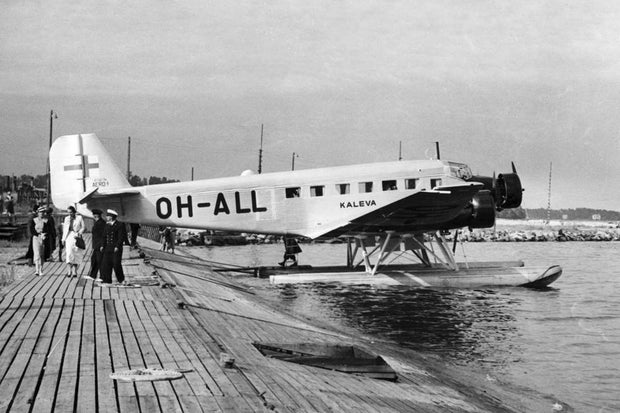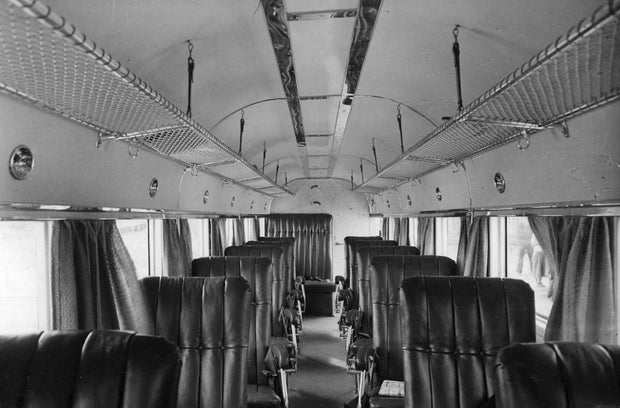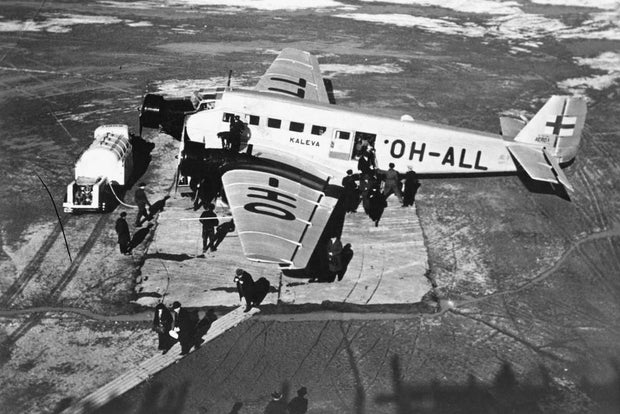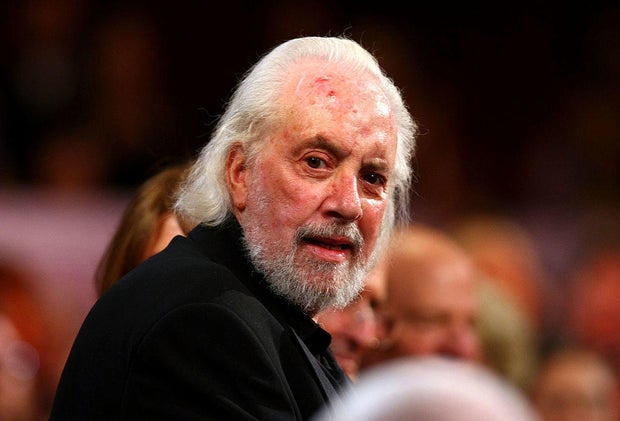CBS News
Remains of WWII-era plane carrying U.S. diplomat and downed by Soviet bombers found by divers

A World War II-era mystery surrounding the disappearance of a Finnish passenger plane carrying American and French diplomatic couriers that was shot down over the Baltic Sea appears to have been solved more than eight decades later.
The plane was en route from Tallinn to Helsinki when it was downed by Soviet bombers on June 14, 1940 – just three months after Finland signed a peace treaty with Moscow following the 1939-40 Winter War. It was also days before Moscow annexed the Baltic states.
/ AP
All nine people on board – a two-member Finnish crew and seven passengers – were killed.
One of the first U.S. casualties of World War II
American diplomat Henry W. Antheil Jr., who is now considered one of the first U.S. casualties of World War II, was aboard the plane when it went down.
The 27-year-old Antheil, the younger brother of the acclaimed composer and pianist George Antheil, was on a rushed government mission evacuating sensitive diplomatic pouches from U.S. missions in Tallinn and Riga, Latvia, as it had become clear that Moscow was preparing to swallow the small Baltic nations.
The other passengers onboard were two French, two Germans, a Swede and a dual Estonian-Finnish national.
Library of Congress via AP
A diving and salvage team in Estonia said this week that it had located well-preserved parts and debris from the Junkers Ju 52 plane operated by Finnish airline Aero, which is now Finnair. It was found off the tiny island of Keri near Estonia’s capital, Tallinn, at a depth of around 70 meters (230 feet).
“Basically, we started from scratch. We took a whole different approach to the search,” said Kaido Peremees, spokesman for the Estonian diving and underwater survey company Tuukritoode OU, explained the group’s success in finding the plane’s remains.
The news about the fate of the plane was met with disbelief and anger by authorities in Helsinki who were informed that it was shot down by two Soviet DB-3 bombers 10 minutes after taking off from Tallinn’s Ulemiste airport.
“It was unique that a passenger plane was shot down during peacetime on a normal scheduled flight,” said Finnish aviation historian Carl-Fredrik Geust, who has investigated Kaleva’s case since the 1980s.
Finland officially kept silent for years about the details of the aircraft’s destruction, saying publicly only that a “mysterious crash” had taken place over the Baltic Sea, because it didn’t want to provoke Moscow.
An 84-year-old mystery
Though well documented by books, research and television documentaries, the 84-year-old mystery has intrigued Finns. The case is an essential part of the Nordic country’s complex World War II history and sheds light into its troubled ties with Moscow.
But perhaps more importantly, the downing of the plane happened at a critical time just days before Josef Stalin’s Soviet Union was preparing to annex the three Baltic states, sealing the fate of Estonia, Latvia and Lithuania for the next half-century before they eventually regained independence in 1991.
Moscow occupied Estonia on June 17, 1940 and Kaleva’s doomed journey was the last flight out of Tallinn, though Soviets had already started enforcing a tight transport embargo around the Estonian capital.
The U.S. Embassy in Tallinn has thoroughly documented and researched the case over the years.
Embassy spokesman Mike Snyder told the AP that “news of the possible location of the wreck of the Kaleva passenger plane is of great interest to the United States, especially since one of the first U.S. casualties of the Second World War, Diplomat Henry Antheil, occurred as a result of the plane being downed.”
Earlier this month, the U.S. ambassador in Estonia, George P. Kent, shared a post on X that included photos of Antheil, Kaleva and a memorial plaque by the American Foreign Service Association in Washington with Antheil’s name engraved in it.
Finnish Aviation Museum via AP
Kaleva was carrying 227 kilograms (500 pounds) of diplomatic post, including Antheil’s pouches and material from two French diplomatic couriers — identified as Paul Longuet and Frederic Marty.
Estonian fishermen and the lighthouse operator on Keri told Finnish media decades after the downing of the plane that a Soviet submarine surfaced close to Kaleva’s crash site and retrieved floating debris, including document pouches, that had been collected by fishermen from the site.
This has led to conspiracy theories regarding the contents of the pouches and Moscow’s decision to shoot down the plane. It still remains unclear why precisely the Soviet Union decided to down a civilian Finnish passenger plane during peacetime.
“Lots of speculation on the plane’s cargo has been heard over the years,” Geust said. “What was the plane transporting? Many suggest Moscow wanted to prevent sensitive material and documents from exiting Estonia.”
But he said that it could have simply been “a mistake” by the Soviet bomber pilots.
Finding the wreckage
Various attempts to find Kaleva have been recorded since Estonia regained independence more than three decades ago. However, none of them have been successful.
Not even the U.S. Navy’s oceanographic survey vessel Pathfinder could locate remains of the plane in a 2008 search around the Keri island in a venture commissioned by the Estonian government from the Pentagon.
“The wreckage is in pieces and the seabed is quite challenging with rock formations, valleys and hills. It’s very easy to miss” small parts and debris from the aircraft, Peremees said. “Techniques have, of course, evolved a lot over the time. As always, you can have good technology but be out of luck.”
New video taken by underwater robots from Peremees’ company show clear images of the three-engine Junkers’ landing gear, one of the motors and parts of the wings.
Peremees and his group are “absolutely” convinced the parts belong to Kaleva because of the distinctive and recognizable design of the German-made Junkers Ju 52, one of the most popular European passenger and wartime transport planes in the 1930s and early 1940s.
Finnish Aviation Museum via AP
The plane was operated by the predecessor of the Finnish national airline Finnair.
Jaakko Schildt, chief operations officer of Finnair, described Kaleva’s downing as “a tragic and profoundly sad event for the young airline” that Finnair, then named Aero, was in 1940.
“Finding the wreckage of Kaleva in a way brings closure to this, even though it does not bring back the lives of our customers and crew that were lost,” Schildt said. “The interest towards locating Kaleva in the Baltic Sea speaks of the importance this tragic event has in the aviation history of our region.”
Peremees said his company would now focus on creating 3D images of Kaleva’s debris and discuss with Estonian authorities about the possibility of raising some of the items and, if found, the plane’s cargo and human remains.
Snyder from the U.S. Embassy in Tallinn said that Washington is closely monitoring the diving group’s efforts.
“We are following the investigation of the site and will be happy to discuss with our Finnish and Estonian (NATO) allies any developments resulting from recovery efforts,” Snyder said.
A stone memorial set up in the early 1990s to the victims of the Kaleva crash is located on Keri, and Helsinki’s old preserved Malmi airport terminal building, where Kaleva was supposed to arrive, has a memorial plaque set up in 2020 with the names of the victims.
CBS News
7/2: CBS Evening News – CBS News

Watch CBS News
Be the first to know
Get browser notifications for breaking news, live events, and exclusive reporting.
CBS News
Robert Towne, legendary Hollywood screenwriter of “Chinatown,” dies at 89

Robert Towne, the Oscar-winning screenplay writer of “Shampoo,” “The Last Detail” and other acclaimed films whose work on “Chinatown” became a model of the art form and helped define the jaded allure of his native Los Angeles, has died. He was 89.
Towne “passed away peacefully surrounded by his loving family” Monday at his home in Los Angeles, his publicist Carri McClure, told CBS News in a statement. She did not provide a cause of death.
In an industry which gave birth to rueful jokes about the writer’s status, Towne for a time held prestige comparable to the actors and directors he worked with. Through his friendships with two of the biggest stars of the 1960s and ’70s, Warren Beatty and Jack Nicholson, he wrote or co-wrote some of the signature films of an era when artists held an unusual level of creative control. The rare “auteur” among screen writers, Towne managed to bring a highly personal and influential vision of Los Angeles onto the screen.
Alberto E. Rodriguez/Getty Images for AFI
“It’s a city that’s so illusory,” Towne told The Associated Press in a 2006 interview. “It’s the westernmost west of America. It’s a sort of place of last resort. It’s a place where, in a word, people go to make their dreams come true. And they’re forever disappointed.”
Recognizable around Hollywood for his high forehead and full beard, Towne won an Academy Award for “Chinatown” and was nominated three other times, for “The Last Detail,” “Shampoo” and “Greystoke.” In 1997, he received a lifetime achievement award from the Writers Guild of America.
“His life, like the characters he created, was incisive, iconoclastic and entirely (original),” said “Shampoo” actor Lee Grant on X.
Towne was born Robert Bertram Schwartz in Los Angeles and moved to San Pedro after his father’s business, a dress shop, closed down because of the Great Depression. His father changed the family name to Towne.
Towne’s success came after a long stretch of working in television, including “The Man from U.N.C.L.E” and “The Lloyd Bridges Show,” and on low-budget movies for “B” producer Roger Corman. In a classic show business story, he owed his breakthrough in part to his psychiatrist, through whom he met Beatty, a fellow patient. As Beatty worked on “Bonnie and Clyde,” he brought in Towne for revisions of the Robert Benton-David Newman script and had him on the set while the movie was filmed in Texas.
Towne’s contributions were uncredited for “Bonnie and Clyde,” the landmark crime film released in 1967, and for years he was a favorite ghost writer. He helped out on “The Godfather,” “The Parallax View” and “Heaven Can Wait” among others and referred to himself as a “relief pitcher who could come in for an inning, not pitch the whole game.” But Towne was credited by name for Nicholson’s macho “The Last Detail” and Beatty’s sex comedy “Shampoo” and was immortalized by “Chinatown,” the 1974 thriller set during the Great Depression.
“Chinatown” was directed by Roman Polanski and starred Nicholson as J.J. “Jake” Gittes, a private detective asked to follow the husband of Evelyn Mulwray (played by Faye Dunaway). The husband is chief engineer of the Los Angeles Department of Water and Power and Gittes finds himself caught in a chaotic spiral of corruption and violence, embodied by Evelyn’s ruthless father, Noah Cross (John Huston).
Influenced by the fiction of Raymond Chandler, Towne resurrected the menace and mood of a classic Los Angeles film noir, but cast Gittes’ labyrinthine odyssey across a grander and more insidious portrait of Southern California. Clues accumulate into a timeless detective tale, and lead helplessly to tragedy, summed up by one of the most repeated lines in movie history, words of grim fatalism a devastated Gittes receives from his partner Lawrence Walsh (Joe Mantell): “Forget it, Jake, it’s Chinatown.”
The back story of “Chinatown” has itself become a kind of detective story, explored in producer Robert Evans’ memoir, “The Kid Stays in the Picture”; in Peter Biskind’s “East Riders, Raging Bulls,” a history of 1960s-1970s Hollywood, and in Sam Wasson’s “The Big Goodbye,” dedicated entirely to “Chinatown.” In “The Big Goodbye,” published in 2020, Wasson alleged that Towne was helped extensively by a ghost writer — former college roommate Edward Taylor. According to “The Big Goodbye,” for which Towne declined to be interviewed, Taylor did not ask for credit on the film because his “friendship with Robert” mattered more.
The studios assumed more power after the mid-1970s and Towne’s standing declined. His own efforts at directing, including “Personal Best” and “Tequila Sunrise,” had mixed results. “The Two Jakes,” the long-awaited sequel to “Chinatown,” was a commercial and critical disappointment when released in 1990 and led to a temporary estrangement between Towne and Nicholson.
Around the same time, he agreed to work on a movie far removed from the art-house aspirations of the ’70s, the Don Simpson-Jerry Bruckheimer production “Days of Thunder,” starring Tom Cruise as a race car driver and Robert Duvall as his crew chief. The 1990 movie was famously over budget and mostly panned, although its admirers include Quentin Tarantino and countless racing fans. And Towne’s script popularized an expression used by Duvall after Cruise complains another car slammed him: “He didn’t slam into you, he didn’t bump you, he didn’t nudge you. He rubbed you.
“And rubbin,′ son, is racin.'”
Towne later worked with Cruise on “The Firm” and the first two “Mission: Impossible” movies. His most recent film was “Ask the Dust,” a Los Angeles story he wrote and directed that came out in 2006. Towne was married twice, the second time to Luisa Gaule, and had two children. His brother, Roger Towne, also wrote screenplays, his credits include “The Natural.”
CBS News
Analyzing impact of Supreme Court’s Trump immunity decision

Watch CBS News
Be the first to know
Get browser notifications for breaking news, live events, and exclusive reporting.













